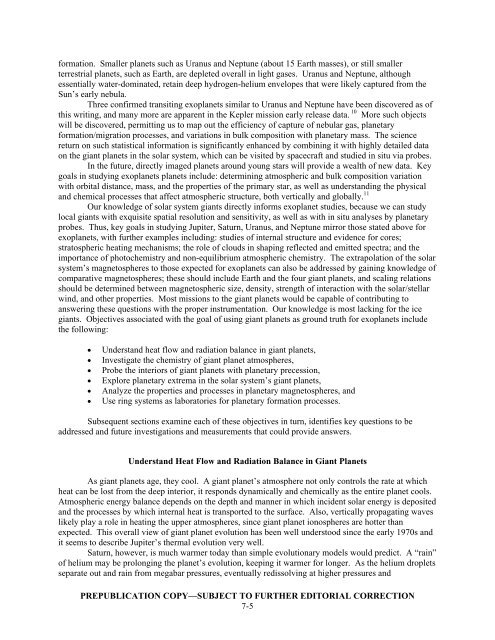Vision and Voyages for Planetary Science in the - Solar System ...
Vision and Voyages for Planetary Science in the - Solar System ...
Vision and Voyages for Planetary Science in the - Solar System ...
Create successful ePaper yourself
Turn your PDF publications into a flip-book with our unique Google optimized e-Paper software.
<strong>for</strong>mation. Smaller planets such as Uranus <strong>and</strong> Neptune (about 15 Earth masses), or still smaller<br />
terrestrial planets, such as Earth, are depleted overall <strong>in</strong> light gases. Uranus <strong>and</strong> Neptune, although<br />
essentially water-dom<strong>in</strong>ated, reta<strong>in</strong> deep hydrogen-helium envelopes that were likely captured from <strong>the</strong><br />
Sun’s early nebula.<br />
Three confirmed transit<strong>in</strong>g exoplanets similar to Uranus <strong>and</strong> Neptune have been discovered as of<br />
this writ<strong>in</strong>g, <strong>and</strong> many more are apparent <strong>in</strong> <strong>the</strong> Kepler mission early release data. 10 More such objects<br />
will be discovered, permitt<strong>in</strong>g us to map out <strong>the</strong> efficiency of capture of nebular gas, planetary<br />
<strong>for</strong>mation/migration processes, <strong>and</strong> variations <strong>in</strong> bulk composition with planetary mass. The science<br />
return on such statistical <strong>in</strong><strong>for</strong>mation is significantly enhanced by comb<strong>in</strong><strong>in</strong>g it with highly detailed data<br />
on <strong>the</strong> giant planets <strong>in</strong> <strong>the</strong> solar system, which can be visited by spacecraft <strong>and</strong> studied <strong>in</strong> situ via probes.<br />
In <strong>the</strong> future, directly imaged planets around young stars will provide a wealth of new data. Key<br />
goals <strong>in</strong> study<strong>in</strong>g exoplanets planets <strong>in</strong>clude: determ<strong>in</strong><strong>in</strong>g atmospheric <strong>and</strong> bulk composition variation<br />
with orbital distance, mass, <strong>and</strong> <strong>the</strong> properties of <strong>the</strong> primary star, as well as underst<strong>and</strong><strong>in</strong>g <strong>the</strong> physical<br />
<strong>and</strong> chemical processes that affect atmospheric structure, both vertically <strong>and</strong> globally. 11<br />
Our knowledge of solar system giants directly <strong>in</strong><strong>for</strong>ms exoplanet studies, because we can study<br />
local giants with exquisite spatial resolution <strong>and</strong> sensitivity, as well as with <strong>in</strong> situ analyses by planetary<br />
probes. Thus, key goals <strong>in</strong> study<strong>in</strong>g Jupiter, Saturn, Uranus, <strong>and</strong> Neptune mirror those stated above <strong>for</strong><br />
exoplanets, with fur<strong>the</strong>r examples <strong>in</strong>clud<strong>in</strong>g: studies of <strong>in</strong>ternal structure <strong>and</strong> evidence <strong>for</strong> cores;<br />
stratospheric heat<strong>in</strong>g mechanisms; <strong>the</strong> role of clouds <strong>in</strong> shap<strong>in</strong>g reflected <strong>and</strong> emitted spectra; <strong>and</strong> <strong>the</strong><br />
importance of photochemistry <strong>and</strong> non-equilibrium atmospheric chemistry. The extrapolation of <strong>the</strong> solar<br />
system’s magnetospheres to those expected <strong>for</strong> exoplanets can also be addressed by ga<strong>in</strong><strong>in</strong>g knowledge of<br />
comparative magnetospheres; <strong>the</strong>se should <strong>in</strong>clude Earth <strong>and</strong> <strong>the</strong> four giant planets, <strong>and</strong> scal<strong>in</strong>g relations<br />
should be determ<strong>in</strong>ed between magnetospheric size, density, strength of <strong>in</strong>teraction with <strong>the</strong> solar/stellar<br />
w<strong>in</strong>d, <strong>and</strong> o<strong>the</strong>r properties. Most missions to <strong>the</strong> giant planets would be capable of contribut<strong>in</strong>g to<br />
answer<strong>in</strong>g <strong>the</strong>se questions with <strong>the</strong> proper <strong>in</strong>strumentation. Our knowledge is most lack<strong>in</strong>g <strong>for</strong> <strong>the</strong> ice<br />
giants. Objectives associated with <strong>the</strong> goal of us<strong>in</strong>g giant planets as ground truth <strong>for</strong> exoplanets <strong>in</strong>clude<br />
<strong>the</strong> follow<strong>in</strong>g:<br />
• Underst<strong>and</strong> heat flow <strong>and</strong> radiation balance <strong>in</strong> giant planets,<br />
• Investigate <strong>the</strong> chemistry of giant planet atmospheres,<br />
• Probe <strong>the</strong> <strong>in</strong>teriors of giant planets with planetary precession,<br />
• Explore planetary extrema <strong>in</strong> <strong>the</strong> solar system’s giant planets,<br />
• Analyze <strong>the</strong> properties <strong>and</strong> processes <strong>in</strong> planetary magnetospheres, <strong>and</strong><br />
• Use r<strong>in</strong>g systems as laboratories <strong>for</strong> planetary <strong>for</strong>mation processes.<br />
Subsequent sections exam<strong>in</strong>e each of <strong>the</strong>se objectives <strong>in</strong> turn, identifies key questions to be<br />
addressed <strong>and</strong> future <strong>in</strong>vestigations <strong>and</strong> measurements that could provide answers.<br />
Underst<strong>and</strong> Heat Flow <strong>and</strong> Radiation Balance <strong>in</strong> Giant Planets<br />
As giant planets age, <strong>the</strong>y cool. A giant planet’s atmosphere not only controls <strong>the</strong> rate at which<br />
heat can be lost from <strong>the</strong> deep <strong>in</strong>terior, it responds dynamically <strong>and</strong> chemically as <strong>the</strong> entire planet cools.<br />
Atmospheric energy balance depends on <strong>the</strong> depth <strong>and</strong> manner <strong>in</strong> which <strong>in</strong>cident solar energy is deposited<br />
<strong>and</strong> <strong>the</strong> processes by which <strong>in</strong>ternal heat is transported to <strong>the</strong> surface. Also, vertically propagat<strong>in</strong>g waves<br />
likely play a role <strong>in</strong> heat<strong>in</strong>g <strong>the</strong> upper atmospheres, s<strong>in</strong>ce giant planet ionospheres are hotter than<br />
expected. This overall view of giant planet evolution has been well understood s<strong>in</strong>ce <strong>the</strong> early 1970s <strong>and</strong><br />
it seems to describe Jupiter’s <strong>the</strong>rmal evolution very well.<br />
Saturn, however, is much warmer today than simple evolutionary models would predict. A “ra<strong>in</strong>”<br />
of helium may be prolong<strong>in</strong>g <strong>the</strong> planet’s evolution, keep<strong>in</strong>g it warmer <strong>for</strong> longer. As <strong>the</strong> helium droplets<br />
separate out <strong>and</strong> ra<strong>in</strong> from megabar pressures, eventually redissolv<strong>in</strong>g at higher pressures <strong>and</strong><br />
PREPUBLICATION COPY—SUBJECT TO FURTHER EDITORIAL CORRECTION<br />
7-5











